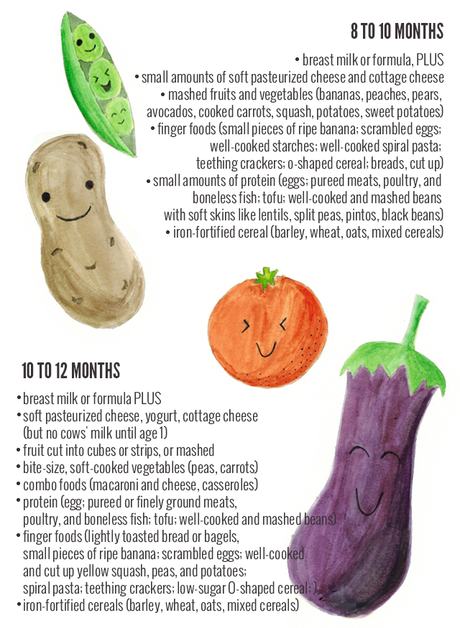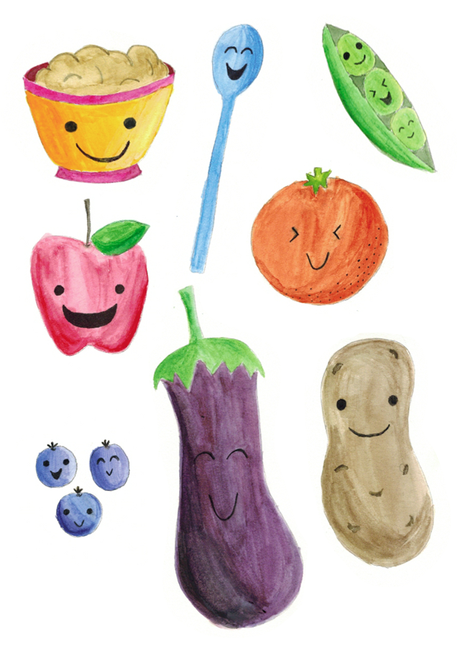

Navigating the world of baby food can be scary. How much are they supposed to eat? When do I start them on solids? What kind of baby cereal? Won't they joke on that? How much?
SO MANY QUESTIONS! It can drive you nuts, and you are already sleep-deprived, so that's the last thing you need, right? Well, lucky for you I have put together a complete baby food guide from birth to 12 months.
Birth to 4 months: Breast milk and/or formula only. Newborns cannot properly digest solids yet. I personally breastfeed on demand every 2-3 hours for the first 4 months, and check to make sure they are having consistent wet and soiled diapers. For formula, a good rule of them to go by is 2.5 oz per body pound in a 24-hour period. So, for a 6 lb newborn, that would be 15 oz, which would roughly be about 2 oz per each feeding if they eat every 3 hours.
Four to 6 months: Now is the time to start introducing basic, pureed fruits and veggies and iron-fortified baby cereal. I personally like to start with apples, bananas, pears, squash, and green beans with rice cereal. I use Earth's Best Organic Rice Cereal. For the first few feedings, start with about 1 teaspoon of cereal. Mix it with water, breastmilk or formula until it is runny. Once your baby gets the hang of it, increase the feedings to 1 tablespoon of rice cereal and 1 tablespoon of your choice of pureed fruit or veggie. Feed twice per day and continue with breastmilk and/or formula feedings. My boys like to eat a lot, so by the time they were 6 months old, they were eating three times per day and about 1/4 cup of both cereal and pureed fruits and veggies. So, take cues from your baby and feed them accordingly. In my experience, babies will eat until they are full and satisfied.
Six to 8 months: Things are starting to get a little more varied now that your baby is getting more teeth. It is safe to add in more of a variety of pureed or strained fruits and veggies, but be sure to introduce them one at a time so you are aware if any allergies pop up. Also, you can start introducing yogurts, pureed meats and legumes (beans, chickpeas, etc). Serving sizes will now increase to 1/2 cup of varied foods, eating three meals per day. Continue with breastfeeding and/or formula.
Eight to 10 months: Baby now has a pincer grasp and can transfer food from hand to hand, so it's not time for finger foods! We generally start feeding our boys whatever we are eating, but mashed and cut up small. Obviously you want to avoid throwing them a slab of medium-rare steak and tough things of that nature, but you can feed your baby well-cooked solid foods, since they should have a few teeth and are able to mash everything with their gums. They will now be eating about 1/8-1/2 cup of each food group (grains, cereal, fruit, vegetables, protein, dairy). Continue with breastfeeding and/or formula.
Ten to 12 months: At this point, baby can eat combo foods and pretty much everything you eat, but cut up small. They should be eating about 1/4-1/2 cup of all the food groups and continue with breastmilk and/or formula.
Things baby should NOT have until one year: Cow's milk, honey (can cause botulism), nuts/hard foods, shellfish, and unpasteurized cheeses. Their digestive systems are still working themselves out, and certain foods can be obvious choking hazards or cause health issues.
I mentioned awhile back when we first started introducing solids to Wes that I made my own pureed baby food. It is great for three reasons: it is cheaper (45% compared to store-bought, which is about an average of $400+ per year), wholesome, and super simple.
Start by cooking your fruit or vegetable until it is soft. This can be done by boiling, baking or microwaving, just as long as it is soft enough. You can to add about 1 teaspoon of water to help it soften. Transfer it into your blender or food processor and add in enough breast milk or water until it is smooth without being too thick or runny. If there are seeds or anything, you can strain those out with a sieve and your food is ready to go! You can make it in big batches and freeze it in ice cube trays, or make it as needed.
As for making pureed meats, I've found that cooked chicken or turkey is easiest to use and you can just throw it in with your baby food batches. I really like these recipes. And honestly, I prefer sticking to making my own meats because a lot of the pre-packaged baby food meats have vegetable oil in them. That just seems totally unnecessary and gross to me.
If you do, however, go the store-bought route, I recommend Earth's Best baby foods. They are organic and come in cute glass jars, which you can repurpose. (Such as this DIY edible fingerpaint!)
So, there you have it! A complete baby food guide from birth to 12 months, straight from my heart, and hand-illustrated by yours truly, even! I hope this is helpful, and please let me know if you have any other questions or suggestions to add!

Disclaimer: I am not a dietitian or certified health professional, and I compiled this list based on my own experiences on what has worked with my two babies, and with some information from a guide on Baby Center. Please be aware that every baby develops at their own pace, and has their own specific needs and health conditions, which may vary from some of the information given.


